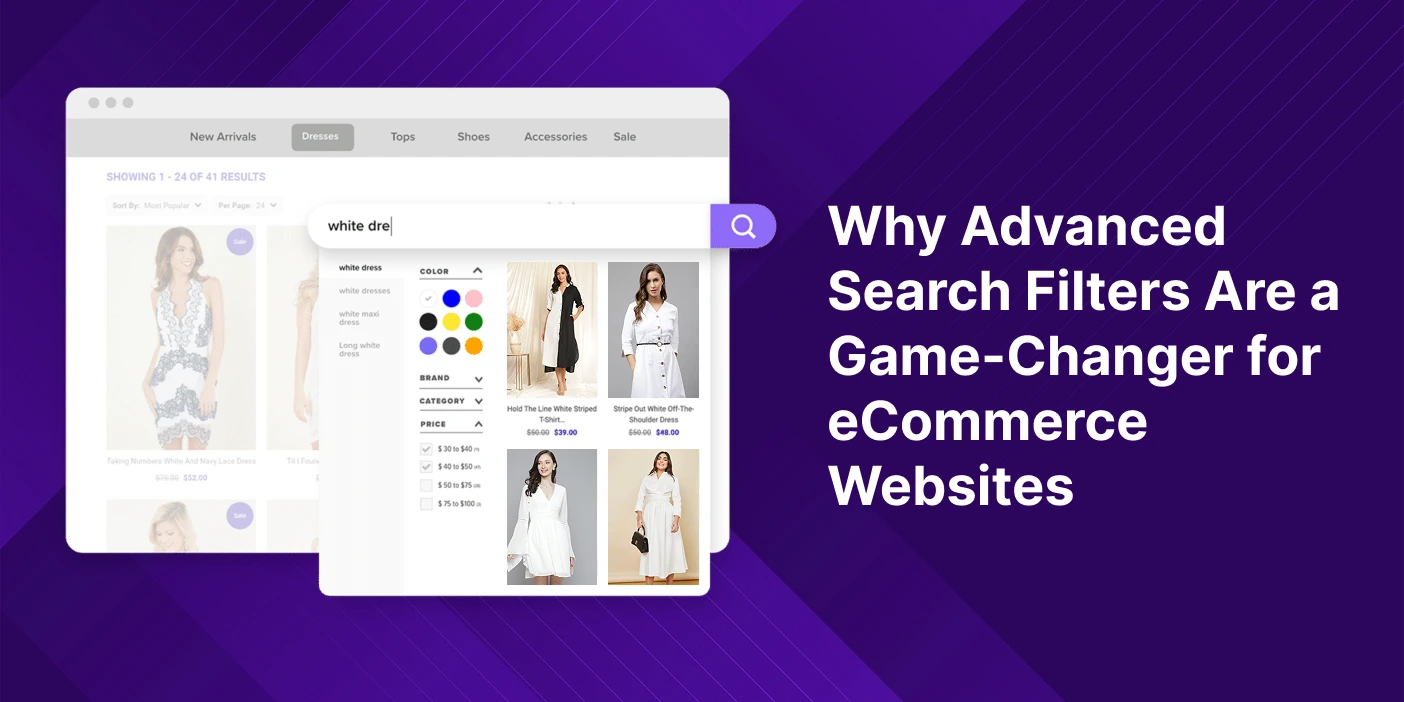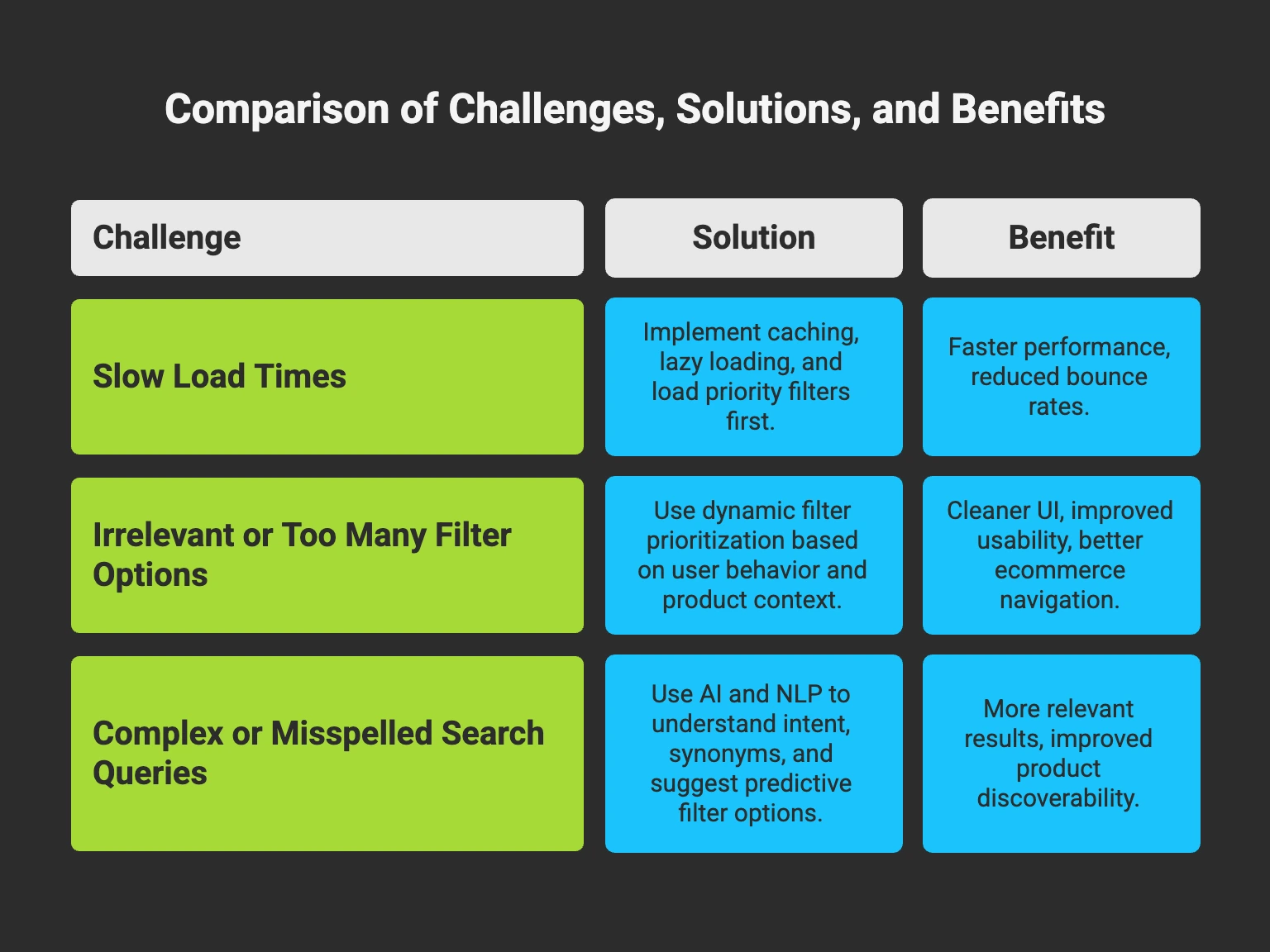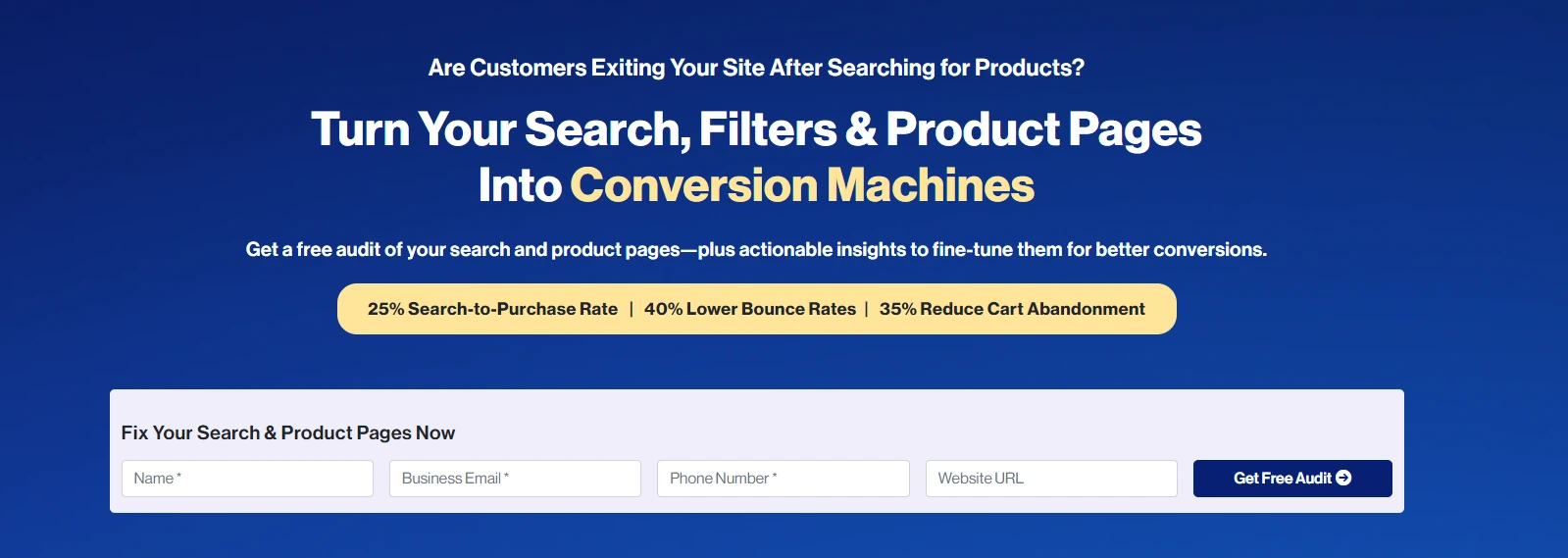Table Of Contents:
Did you know that 80% of online shoppers are more likely to buy from a site that offers personalized, filter-driven navigation? (Source: Forbes)
31% of product discovery tasks fail due to inadequate search functionality. (Source: LLCBuddy)
Today, shoppers expect more than just a search bar. They want e-commerce search filters that understand their intent and preferences, guide them effortlessly, and refine thousands of SKUs down to the perfect product in seconds. Whether it’s filtering by brand, price, size, color, or even customer reviews, these intuitive tools dramatically improve ecommerce navigation and shorten the path to purchase.
Thesis:
“Advanced search filters revolutionize e-commerce by improving product discovery and conversions.”
What Are Advanced Search Filters?
Advanced search filters, often called faceted search, allow users to refine product results using multiple attributes. Unlike basic search functionality that returns results for a keyword, advanced filters enable precise product exploration based on user-defined criteria.
It breaks down large product catalogs into manageable, meaningful segments using categories like:
- Price range (e.g., $50–$100)
- Brand (e.g., Nike, Apple, Samsung)
- Size & fit (e.g., S, M, L, XL)
- Color variants
- Customer ratings
- Availability (in stock, pre-order)
These e-commerce search filters offer search refinement that enhances user-friendly navigation by guiding users with intent-driven browsing paths.
Why Advanced Search Filters Matter for E-commerce
In today’s ultra-competitive e-commerce landscape, product abundance is both a strength and a struggle. As catalogs grow, so does the complexity of helping shoppers find what they actually want. Unfortunately, many e-commerce sites still rely on outdated or basic filtering systems, leading to poor discoverability, increased frustration, and, ultimately, lost sales.
1. To Handle Big Catalogs & Low Discoverability
E-commerce brands—from fashion and home décor to electronics and cosmetics—offer hundreds to thousands of SKUs. Without smart filtering, customers get lost in endless scrolling or irrelevant results, leading to tedious store catalog management.
Advanced search filters help break down massive catalogs into manageable, intuitive options. With faceted search (e.g., price range, color, brand, size), shoppers can navigate directly to products that match their exact needs—reducing friction and driving faster conversions.
2. To Manage Frustrated Users & High Bounce Rates
Shoppers today expect fast, accurate results. Users feel overwhelmed or annoyed if filters are too broad or missing key attributes. Inconsistent filtering, or worse, zero-result searches, create frustration and lead users to abandon their session.
Precise search refinement through dynamic, relevant filters ensures shoppers stay engaged, creating a smoother, user-friendly navigation experience that increases time on site and trust in the brand.
3. Catering to Diverse Shoppers Preferences and Complex Queries
Your audience is diverse—some know exactly what they’re looking for (“4K 55-inch TV under $500”), while others browse based on mood, trend, or inspiration. Rigid or static filters can’t serve both.
Advanced e-commerce search filters cater to complex, nuanced queries while also supporting flexible discovery paths. That means better personalization, more accurate results, and higher chances of conversion—whether it’s a first-time visitor or a returning customer.
Supercharge Your Site Search & Product Discovery
Discover how our AI can transform your product discovery and boost conversions.
Key Benefits of Advanced Search Filters
Advanced search filters enhance the overall shopping experience, streamline e-commerce navigation, and boost business performance. Here’s how e-commerce stores can benefit from them:
1. Improved User Experience
- Simplifying Navigation for Mobile and Desktop Users
- What it means: Advanced filters make the search process quick and easy whether your customer is shopping on their phone or desktop.
- Example: A clothing store adds filters for size, color, brand, and style. This allows a customer to refine their search, improving navigation and saving time immediately.
- Why it matters: A smoother navigation process leads to higher customer satisfaction and reduces frustration, especially on mobile where space is limited.
- Faster Product Discovery Through Intuitive Filter Options
- What it means: By offering customers multiple filtering options such as price range, brand, rating, etc., you reduce the time it takes to find the right products.
- Example: A furniture ecommerce site offers filters for type (e.g., sofa, chair), material, color, and price. This helps a customer quickly find the perfect item without endless scrolling.
- Why it matters: Shoppers are more likely to complete a purchase when they can easily find exactly what they want.
2. Increased Conversion Rates
- How Filters Guide Shoppers to Relevant Products
- What it means: Filters help guide shoppers directly to products that match their needs, reducing the risk of frustration or abandonment.
- Example: A tech store selling laptops provides filters like screen size, processor type, and storage capacity, enabling customers to find the perfect device faster.
- Why it matters: When customers find exactly what they’re looking for, they are more likely to convert.
- Reducing Bounce Rates by Minimizing “No Results” Pages
- What it means: Advanced search filters prevent customers from landing on a “no results” page, which can lead to frustration and abandonment.
- Example: An online bookstore offers filters for genre, author, and price range. If a user is looking for “mystery novels under $20,” the filters ensure relevant results are shown.
- Why it matters: Keeping customers engaged with relevant products improves bounce rates and keeps them on your site longer, increasing the chances of a sale.
3. Personalization and Engagement
- Tailoring Filters to User Behavior and Preferences
- What it means: Personalizing the filter options based on past behaviors and preferences can enhance the shopping experience.
- Example: An online clothing store could show size and color filters based on a customer’s past purchases. Returning customers might see their recently viewed items appear as filter options.
- Why it matters: Personalization increases engagement, as customers feel like the shopping experience is tailored to their unique needs.
- Encouraging Repeat Visits Through Customized Search Experiences
- What it means: Providing a personalized search experience increases the likelihood of return visits.
- Example: A beauty retailer can customize filters to show products based on a customer’s skin type, shades they’ve purchased before, and seasonal preferences.
- Why it matters: Personalized search makes customers feel understood, fostering loyalty and encouraging repeat visits to your store.
4. SEO and Analytics Benefits
- Supporting SEO Through Filter-Generated Landing Pages
- What it means: Filter-generated landing pages can be indexed by search engines, helping improve SEO for long-tail keywords.
- Example: A jewelry store creates a landing page for “gold necklaces under $500” based on user filtering. This page can be indexed and ranked for specific search queries.
- Why it matters: These filter-based landing pages help improve organic search visibility and drive more targeted traffic to your site.
- Leveraging Filter Analytics to Understand Shopper Intent
- What it means: Filter usage provides insights into what your customers are searching for and their preferences.
- Example: An e-commerce website can analyze which filters (e.g., price range, brand, color) are most frequently used, and adjust product offerings or promotions based on this data.
- Why it matters: Understanding shopper intent allows you to optimize your inventory, marketing efforts, and overall user experience to better meet customer needs.
Want to see how your current site search stacks up?
Get your free ecommerce site search audit here – uncover quick wins and conversion boosters!

Real-World Examples of Advanced Search Filters in Ecommerce
Advanced search filters have been transformative for leading ecommerce brands, driving better user experience, higher conversions, and improved retention. Here’s how top companies have leveraged this feature:
1. Amazon: Precision in Product Discovery
Amazon’s vast catalog overwhelmed users, leading to abandoned searches and irrelevant results. Amazon implemented faceted search filters, allowing customers to narrow down products by brand, price, ratings, and more.
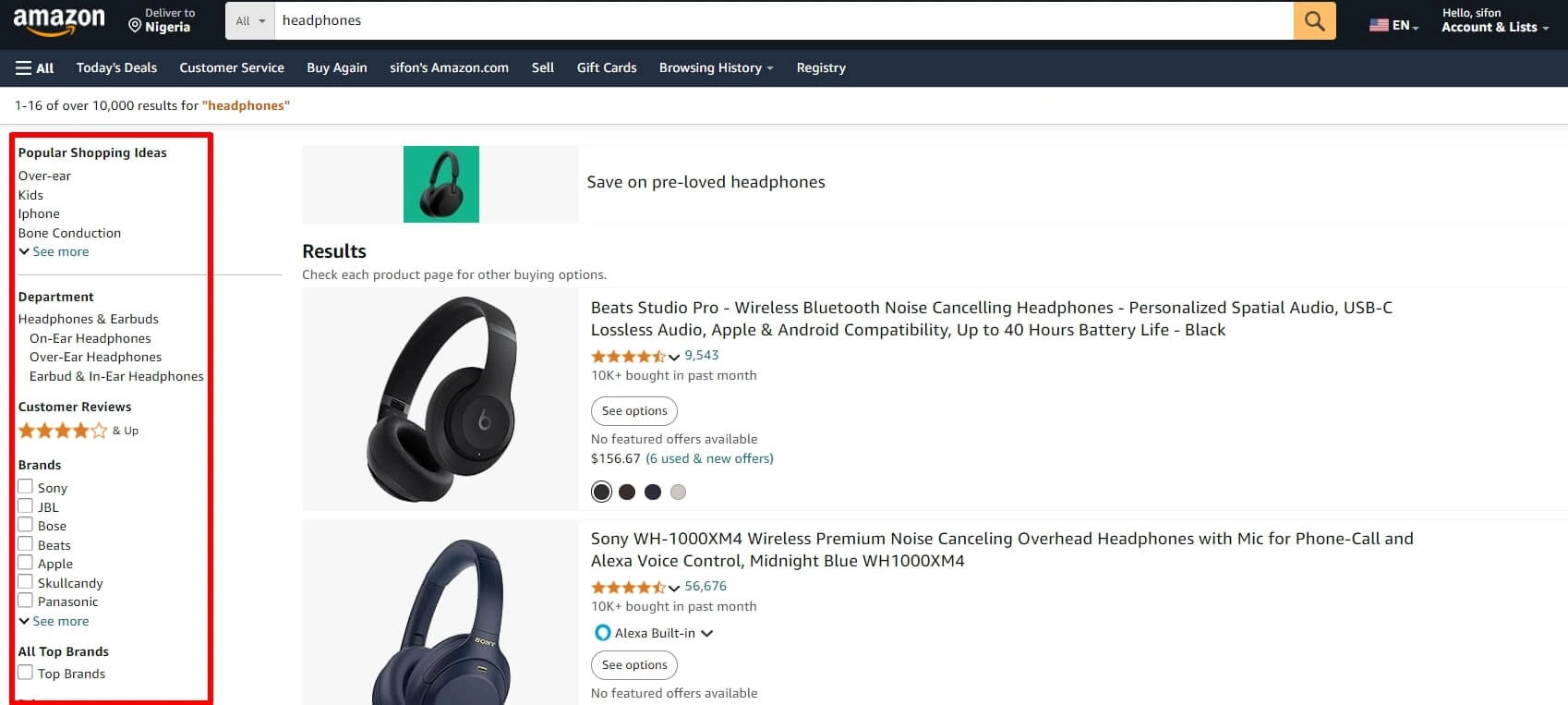
Source: Amazon
The Impact & Takeaway
Advanced search filters boost sales by speeding up product discovery and reducing cart abandonment. They enhance customer satisfaction with accurate search results and improve retention through personalized filters. Key takeaways include the importance of granular filters and ongoing system improvements for a better user experience.
2. Zappos: Reducing Frustration in Shoe Shopping
Zappos’ large shoe selection overwhelmed shoppers, making it hard to find the perfect pair. Dynamic filters by size, style, color, brand, and material helped customers refine their search.
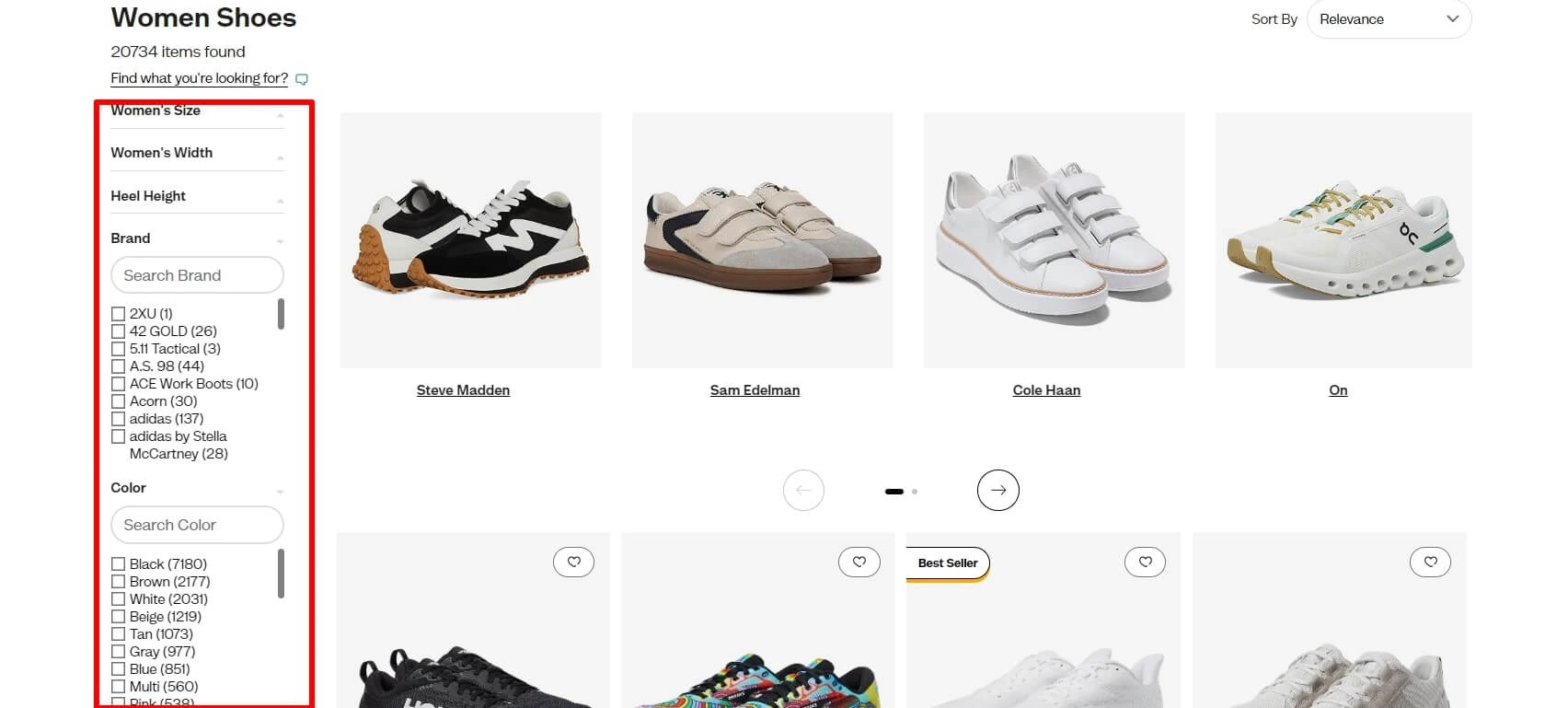
Source: Zappos
The Impact & Takeaway
Advanced search filters significantly impact sales, driving higher conversions and reducing bounce rates through improved precision. They enhance customer satisfaction by offering easier navigation and tailored results while boosting retention with personalized filtering. Key lessons include the importance of customization and mobile optimization to drive engagement and sales.
Balancing Functionality and Usability
Advanced search filters can make or break the shopping experience. When designed right, they guide users effortlessly to what they’re looking for. But if overloaded or poorly implemented, they can confuse shoppers and hurt conversions. That’s why balancing powerful functionality with clean, user-friendly navigation is crucial.
Avoiding Filter Overload
Offering too many filter options at once can overwhelm shoppers and lead to decision fatigue. Smart ecommerce stores prioritize key filters—like price, size, or rating—while tucking away niche filters behind expandable menus. A clean interface encourages exploration, not exits.
Optimizing for Mobile Shoppers
With the majority of shoppers browsing on mobile, responsive filter design is a must. Features like sticky filter bars, collapsible menus, and swipeable filter chips ensure users can apply filters easily without struggling on small screens. Mobile-first design keeps the journey smooth.
Using AI and NLP for Smarter Filtering
AI and Natural Language Processing (NLP) take ecommerce search filters to the next level. By understanding user intent—like “eco-friendly shoes under $100”—the system automatically applies relevant filters. This dynamic filtering reduces effort and delivers hyper-relevant results instantly.
Uncover Hidden Gaps in Your Search and Product Filters
Get a free product discovery audit and find opportunities to improve conversions.
Future Trends in Advanced Search Filters (2025 and Beyond)
As ecommerce evolves, so do shopper expectations. The next generation of search filters will go beyond basic functionality, tapping into AI, behavior prediction, and immersive technologies to deliver hyper-relevant, intuitive, and engaging product discovery experiences.
AI-Driven Hyper-Personalization
- Filters will adapt in real-time based on individual user profiles, browsing patterns, and purchase history.
- Example: A skincare shopper will automatically see filters tailored to their skin type, past brands, and seasonal needs.
- Benefit: Enhanced relevance, reduced time-to-purchase, and higher conversion rates.
Voice-Activated & Visual Search Filters
- Shoppers will refine searches using voice commands or by uploading photos.
- Example: “Show me red sneakers under $100” or filtering results based on a picture of a product.
- Benefit: Hands-free, faster discovery and improved accessibility.
Predictive Filters Based on Real-Time Behavior
- Filters will dynamically update based on how users interact with the site—like hovering, clicks, and scroll depth.
- Example: A user exploring high-end watches may be shown premium filter categories like “Swiss Movement” or “Luxury Brand.”
- Benefit: Intelligent ecommerce navigation that shortens the path to purchase.
How to Implement Advanced Search Filters
Implementing advanced search filters isn’t just about adding dropdowns and checkboxes—it’s about crafting an intelligent, seamless search experience that aligns with how your customers think and shop. Here’s how to get it right:
1. Choosing the Right Technology
The foundation of effective search filtering is built on technology that’s flexible, scalable, and performance-driven. Whether you’re using a CMS(like Shopify, Magento), a headless architecture, or custom-built systems, ensure the infrastructure supports:
- Real-time indexing for fast product updates
- Rich metadata and attribute management
- Easy integration with your backend inventory and analytics systems
Your platform should allow for dynamic filtering, personalized suggestions, and scalability as your catalog grows.
2. Best Practices for Filter Design and Placement
Well-designed filters guide users intuitively and reduce friction. Follow these UX best practices:
- Visibility and Accessibility: Place filters in expected areas—left sidebar on desktop, collapsible top bars on mobile.
- Logical Grouping: Organize filters into categories like price, brand, color, size, etc., and use hierarchy or progressive disclosure for deeper options.
- Clear Labels: Use shopper-friendly terms instead of internal jargon (e.g., “Size” instead of “SKU variant”).
- Multi-Select Options: Allow users to select multiple values within a category for better refinement.
- Real-Time Feedback: Apply filters without page reloads and show the number of results dynamically.
User-Friendly Navigation = Faster Decisions = Higher Conversions
3. Testing and Iterating Based on User Feedback and Analytics
Filters are not “set it and forget it.” Monitor how users interact with filters, which ones they use most, and where drop-offs happen. Leverage tools like heatmaps, session recordings, and filter usage reports to uncover improvement areas.
- A/B Test Filter Placements and Names: Small UI changes can significantly impact usage.
- Track Filter Combinations: Identify high-converting filter paths to inform merchandising strategies.
- User Surveys & Feedback Loops: Ask real users what worked and what didn’t during their search experience.
Conclusion
Advanced search filters are no longer a luxury for ecommerce websites—they are a necessity. By enhancing product discoverability, boosting conversion rates, and personalizing the user experience, these filters help both businesses and shoppers navigate vast catalogs with ease. Whether it’s faceted search, product filtering, or refined e-commerce navigation, implementing advanced search solutions directly translates into improved customer satisfaction and business growth.
Investing in advanced search filters is key to stay ahead of the competition. Not only will it improve user engagement, but it will also drive sales and foster repeat business.
Not sure where your site stands?
Get a free audit of your search and product pages from ConversionBox and uncover instant wins.
As ecommerce evolves, keeping an eye on emerging trends—like AI-driven filters, voice search, and predictive features—will ensure your website remains a top choice for customers. Adapt now for future success in the ever-changing digital landscape.
Boost Your eCommerce Conversion Rates with Expert Guidance
Get a free consultation with our conversion specialists to tackle your biggest challenges.









